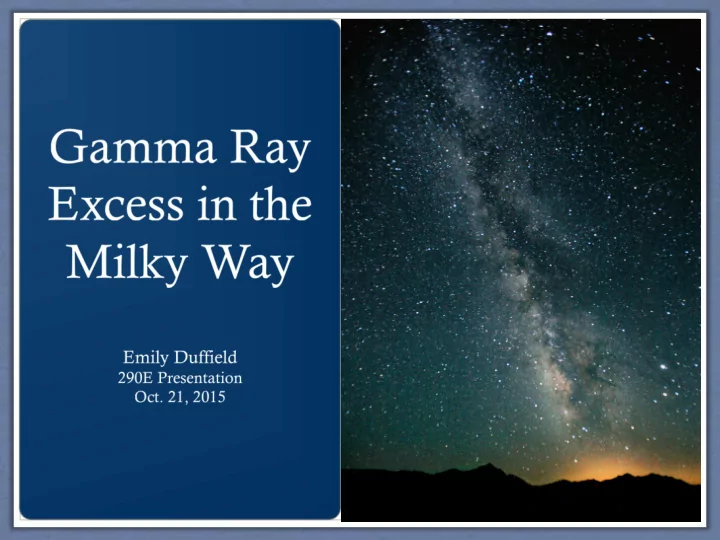

Outline
Galaxy Terminology 1 kpc = 3.26 light-years = 3.086*10 19 meters • The galactic coordinates use the Sun as the origin. • Galactic longitude (l) is measured with primary direction from the Sun to the center of the galaxy in the galactic plane. • Galactic latitude (b) measures the angle of the object above the galactic plane.
Galactic Center (I) The Galactic Center is 25,000 light years away from our Sun.
Galactic Center (II) • The size of this image is about 10 by 15 degrees in size. • For scale comparison, if you held a closed fist out at arm’s length, it would cover 5 degrees on the sky. • Small signal space • Large amounts of stellar dust between us and galactic center make it harder to study.
Dark Matter in Galaxies • Galaxy rotation curve for the Milky Way. Vertical axis is speed of rotation about center. Observed curve of speed of rotation is blue line. Predicted curve is red line. • We expect at larger distances for the velocity to slow, yet it does not. à dark matter? • Most likely dark matter candidate is WIMPs • If WIMPs annihilate, they can produce gamma rays which are identifiable from dense astrophysical background
Fermi Large Area Telescope • Fermi LAT is an imaging, high-energy gamma-ray telescope launched into near-earth orbit 11 June 2008 • Sensitive to gamma rays within an energy range of 20 MeV to more than 300 GeV • Such gamma rays are emitted only in the most extreme conditions by particles moving at the speed of light • Field of view covers 20% of the sky at any time and it scans continuously, covering the whole sky every three hours • gamma rays cannot be refracted by a lens or focused by a mirror à detected using the same technology as particle accelerators
Fermi Large Area Telescope • Incoming gamma ray pass freely through the thin plastic anticoincidence detector • They continue until they interact with an atom in one of the thin tungsten foils producing an electron and a positron. • They proceed on, creating ions in thin silicon strip detectors. • The silicon strips alternate in the X and Y directions allowing the progress of the particles to be tracked. • Finally the particles are stopped by a cesium iodide calorimeter which measure the total energy deposited à energy and direction of the gamma ray.
Gamma Ray & Dark Matter • Fermi hopes to observe the flux of dark matter annihilation products, including gamma rays produced by the innermost volume of the Milky Way’s halo. • The flux of such gamma rays is described as: gamma ray spectrum dark matter generated per annihilation annihilation cross section ! $ ) = dN γ σ v ρ 2 r ( ∫ ( ) Φ γ E γ , ψ # & dl Flux = # & 2 dE γ 8 π m X " % los dark matter density as a function of distance to angle observed dark matter mass the Galactic Center relative to the direction of the where γ is the Galactic Center ρ ∝ r − γ inner slope of the halo
Modeling the Backgrounds Diffuse emission from the disk (top left) –inverse Compton, Bremsstrahlung, neutral • pion decay. Emission from point sources – like Fermi Bubbles (top right) • Dark Matter annihilation products (bottom) • b l red box indicates area of interest
Gamma Ray Emission Spectra • Regions of Interest: • Galactic Center | l | < 2 o , | b | < 2 o • Galactic Disk | l | > 2 o • Spectra are usually analyzed in multiple bins of various l and energy. • Free parameter γ ranges from 1.1-1.3 depending upon the fit and analysis. • Recall, γ is the measure of the inner dark matter halo slope
Gamma Ray Emission Spectra • Total observed gamma ray spectrum in various ranges of angular distance from the Galactic Center. • Outside of 1.25 o from Galactic Center, model describes data well. • Closer to Galactic Center, the spectral shape of the observed emission is significantly different, peaking between 1-3 GeV • Two years of data taken from 2008-2010. dotted: bulge dashed: disk solid: sum
Gamma Ray Emission Spectra – Dark Matter • Raw gamma ray maps (left) and the residual maps after subtracting the background models (right) • Right frames clearly contain a significant central and spatially extended excess peaking at ~1-3 GeV. • 5+ years of data arXiv:1402.6703v2 [astro-ph.HE] 17 Mar 2015
Gamma Ray Emission Spectra – Dark Matter Spectrum of dark matter component, extracted from the fit. • Shown for comparison is the spectrum predicted from a 43.0 GeV dark matter particle annihilating to • bb-bar with a cross section of arXiv:1402.6703v2 [astro-ph.HE] 17 Mar 2015
Is it dark matter? • The other options considered were: • Millisecond Pulsars • Cosmic Ray outbursts from the Galactic Center • Both of these alternative explanations were rejected due to characteristics of the data. • Cosmic Ray outbursts would not explain excess given that the diffuse emission background includes contributions from gas in Galactic Center. • Millisecond Pulsars are consistently softer than that of the observed excess at energies below ~1 GeV
Conclusion • Fermi data has been available for several years, and multiple teams have analyzed the data. • While the exact dark matter candidate varies based on statistical fluctuations in the fit, all can agree that: “we have confirmed a robust and highly statistically significant excess, with a spectrum and angular distribution that is in excellent agreement with that expected from annihilating dark matter”. Einstein@Home
Recommend
More recommend